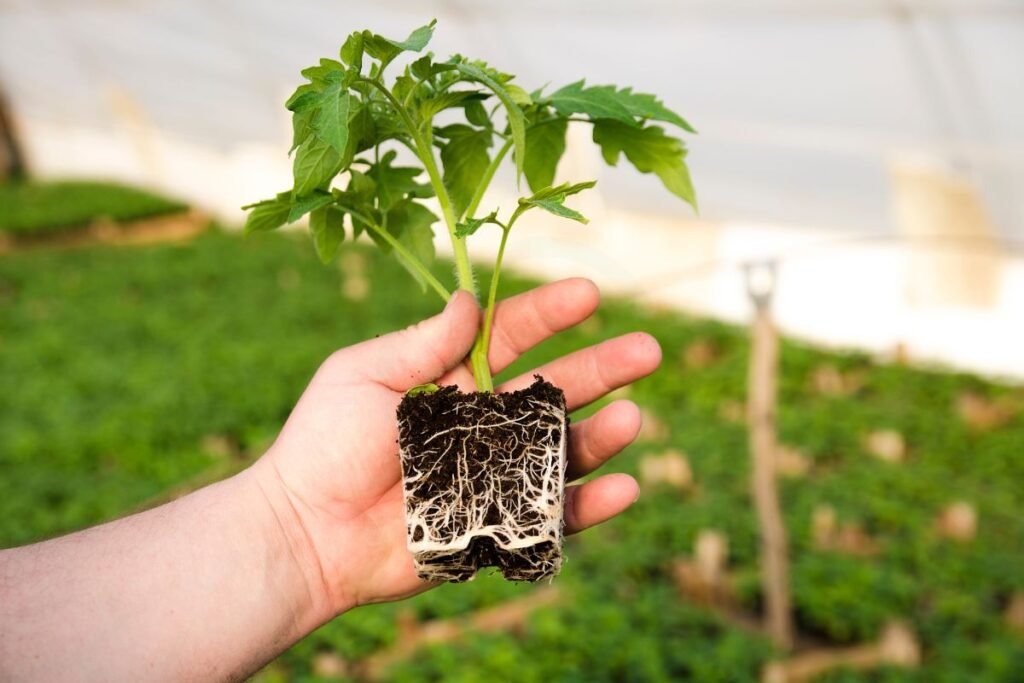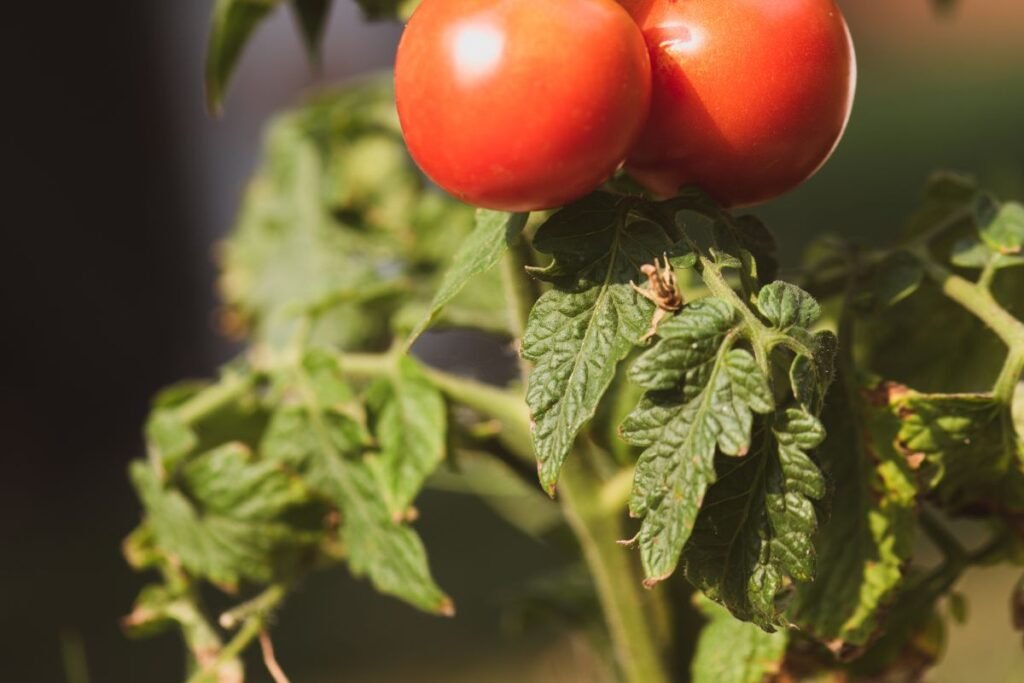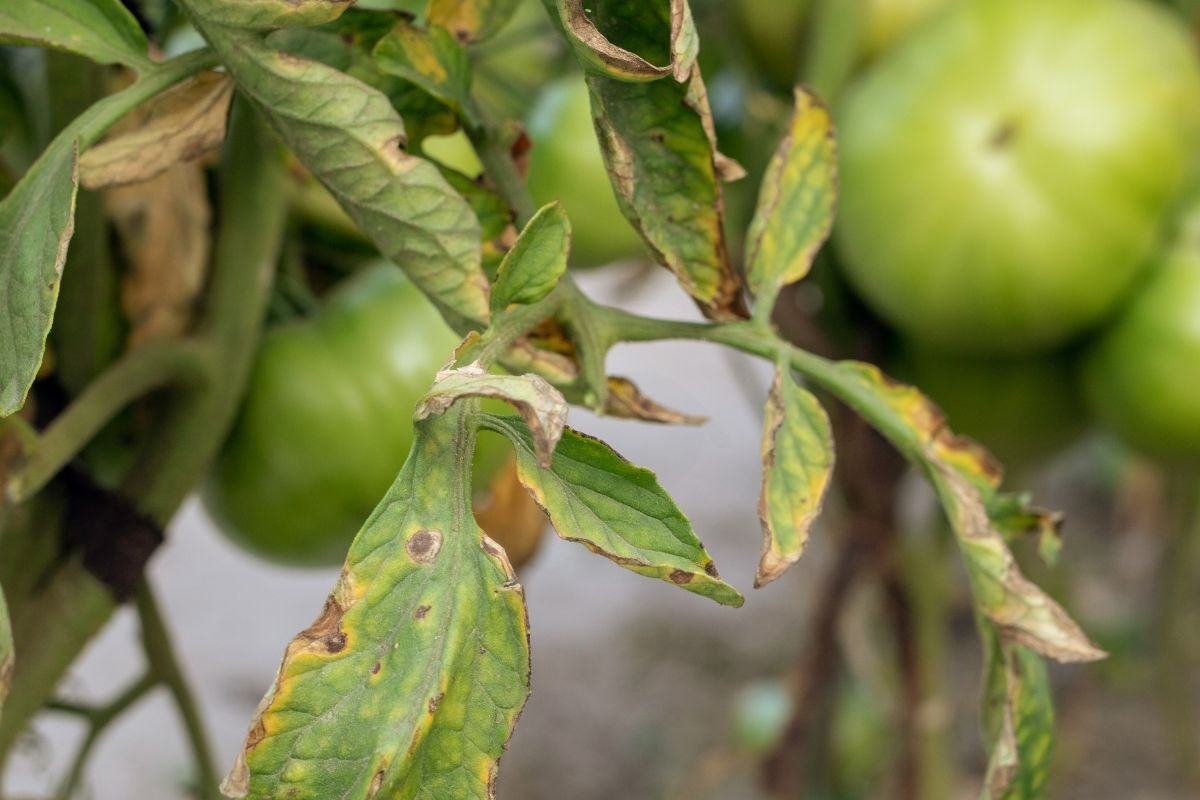Surprisingly, overwatering is a common culprit behind tomato plants developing brown leaves. This issue, caused by fungus, can lead to root rot, hindering the plant's ability to absorb nutrients properly. Nutrient deficiencies, particularly in potassium and magnesium, can manifest as browning leaves on tomato plants. Ensuring the right balance of these essential nutrients is crucial for healthy foliage.
Understanding the reasons behind browning leaves on tomato plants is vital for maintaining a thriving garden. By identifying and addressing these issues promptly, you can help your tomato plants flourish and yield a bountiful harvest. Stay tuned for expert tips on how to prevent and treat brown leaves on your tomato plants.
Key Takeaways
Understanding Browning Leaves:
-
Browning leaves on tomato plants can be a sign of various issues like nutrient deficiencies, diseases, or environmental stress.
-
For example, inadequate watering or over-fertilization can lead to leaf browning.
-
To address this, ensure your tomato plants receive sufficient water and nutrients based on their specific requirements.
-
Dehydration Effects:
-
Dehydration is a common cause of browning leaves in tomato plants, impacting their overall health and productivity.
-
Lack of water can result in wilting, curling, and eventual browning of the leaves.
-
To prevent dehydration, regularly check the soil moisture levels and water your tomato plants consistently, especially during hot weather.
-
Pests and Diseases:
-
Pests like aphids and diseases such as early blight can cause leaves to turn brown on tomato plants.
-
These issues can weaken the plant and affect fruit production.
-
Implement pest control measures and use disease-resistant tomato varieties to minimize the risk of browning leaves.
-
Verticillium Wilt:
-
Verticillium wilt is a fungal disease that can lead to browning and wilting of tomato plant leaves.
-
This disease can persist in the soil for years, affecting future plantings.
-
Practice crop rotation and soil sterilization to manage Verticillium wilt and prevent its spread.
-
Garden Hygiene Practices:
-
Maintaining good garden hygiene is essential to prevent the spread of diseases that cause browning leaves.
-
Remove and destroy any infected plant debris promptly to reduce the risk of contamination.
-
Regularly clean gardening tools to prevent the transmission of pathogens between plants.
-
Addressing Canker:
-
Canker, a bacterial infection, can result in browning lesions on tomato plant stems and leaves.
-
Infected plants should be removed to prevent the spread of the disease to healthy plants.
-
Disinfect pruning tools between each cut when dealing with canker-infected plants.
-
Understanding Browning Leaves
To understand why the leaves on your tomato plant are turning brown, it is essential to delve into the common causes behind this issue. Browning leaves can be a signal of various underlying problems that need attention.
Common Causes
-
Overwatering is a frequent culprit for brown leaves as it leads to root rot, inhibiting the plant's ability to absorb nutrients.
-
Fungal diseases, such as early blight or septoria leaf spot, can cause dark brown spots on the leaves.
-
Nutrient deficiencies, particularly in essential minerals like potassium or magnesium, can manifest as brown edges or tips on the foliage.
Understanding these factors is crucial as they directly impact the overall health and vitality of your tomato plants. By recognizing the root causes of browning leaves, you can take proactive measures to address them promptly.
Impact on Tomato Health
Brown leaves not only detract from the aesthetic appeal of your tomato plants but also have detrimental effects on their health. When left unattended, brown leaves can impede photosynthesis and nutrient absorption, stunting growth and reducing fruit production significantly.
Addressing brown leaves promptly is vital to ensure optimal plant health and maximize fruit yield. By tackling this issue early on, you can safeguard the overall well-being of your tomato plants and promote robust growth.
Identifying Symptoms
Visual symptoms of browning leaves on tomato plants may vary depending on the underlying cause. Early signs often include dark brown spots, wilting foliage, or yellowing in conjunction with browning. Distinguishing between different causes of browning requires keen observation and knowledge of common indicators.
Typical signs to look out for include dark brown patches spreading across the leaves, yellowing starting from the bottom up, or wilting despite adequate watering. These visual cues provide valuable insights into diagnosing and addressing the specific issues causing leaf browning.
Dehydration Effects
To understand why the leaves on your tomato plant are turning brown, it's crucial to grasp the effects of dehydration. Dehydration occurs when a plant doesn't receive enough water to maintain its normal functions.
Signs of Underwatering
Underwatering in tomato plants manifests through specific signs such as wilting leaves, dry soil, and curling leaf edges. Recognizing these signs early is vital to prevent further damage. It's essential to differentiate between underwatering and other problems like overwatering or nutrient deficiencies.
Inadequate watering can lead to stunted growth and ultimately affect the plant's ability to produce fruits. By observing the plant closely and addressing dehydration promptly, you can save your tomato plant from irreversible damage.

Proper Watering Techniques
To prevent brown leaves on tomato plants, it's essential to follow proper watering techniques. Water deeply but infrequently, allowing the soil to dry slightly between watering sessions. Ensure that water reaches the roots by watering at the base of the plant rather than overhead.
Overhead watering can lead to fungal diseases and contribute to leaf browning. Mulching around the base of the plant helps retain moisture in the soil and reduces evaporation. Consistent watering schedules based on weather conditions and plant needs are key to maintaining healthy tomato plants.
Pests and Diseases
To maintain the health of your tomato plants, it is essential to address issues like Spider Mites, Bacterial Leaf Spot, and Fungal Infections promptly.
Spider Mites
Identification
Accurately identifying the cause of brown leaves is crucial for effective treatment. Misidentification can lead to ineffective solutions. Look for tiny pests on the undersides of leaves.
Control Measures
- Regularly inspect the plant for spider mites.
- Use insecticidal soap or neem oil to control infestations effectively.
- Prune affected leaves and dispose of them properly to prevent the spread of mites.
Bacterial Leaf Spot
Recognizing Symptoms
Early recognition of symptoms is key to preventing further damage. Specific symptoms include dark spots with yellow halos on leaves. Act swiftly upon noticing these signs.
Treatment Options
- Apply copper-based fungicides to manage bacterial leaf spot effectively.
- Ensure proper air circulation around plants to reduce humidity levels.
- Avoid overhead watering to prevent the spread of bacteria.
Fungal Infections
Early Blight
Early blight affects tomato plants, causing dark concentric rings on leaves. Proper management involves removing infected foliage promptly. Apply fungicides containing chlorothalonil for control.
Late Blight
Late blight results in water-soaked lesions on leaves, leading to plant wilting. Implement preventive measures like spacing plants adequately and watering at the base to minimize infection risk.
Verticillium Wilt
To effectively manage the issue of brown leaves on tomato plants, it's crucial to understand Verticillium Wilt. This fungal disease affects the plant's vascular system, leading to wilting and browning of leaves.
Spotting Symptoms
Spotting symptoms early is vital in preventing further damage to your tomato plants. Yellowing or browning of lower leaves is a common early sign of Verticillium Wilt. Another key symptom is wilting during the day, even when the soil is moist.
Recognizing these symptoms promptly allows you to take action before the disease spreads. By addressing these signs early, you can prevent the spread of infection to other parts of the plant, promoting overall plant health.
Management Strategies
Effective management strategies are essential for dealing with brown leaves caused by Verticillium Wilt. One approach is pruning infected branches to prevent the disease from spreading further within the plant. proper irrigation practices can help maintain plant health and reduce stress on affected plants.
Proactive management plays a significant role in preventing leaf browning on tomato plants. Regularly inspecting your plants for symptoms and promptly addressing any issues can help minimize the impact of diseases like Verticillium Wilt.
Implementing successful management strategies involves maintaining good garden hygiene by removing any diseased plant material promptly. Furthermore, rotating crops annually can help reduce the risk of disease recurrence in your garden.
Garden Hygiene Practices
To maintain healthy tomato plants and prevent brown leaves, cleanliness plays a crucial role. Ensuring a clean garden environment is essential in warding off diseases that can cause leaf discoloration. By regularly cleaning your garden, you reduce the risk of pathogens spreading and infecting your plants.
Plant debris left on the soil surface can harbor harmful bacteria and fungi, leading to diseases like early blight or Septoria leaf spot. To promote plant health and prevent brown leaves, remove any fallen leaves, fruits, or stems from the garden bed. This simple practice can significantly reduce the chances of disease outbreaks.

Implementing good garden hygiene practices involves keeping tools and equipment clean as well. Dirty tools can transfer pathogens from one plant to another, increasing the likelihood of infections. Regularly sanitize your gardening tools with a solution of bleach or alcohol to minimize this risk.
Importance of Cleanliness
Maintaining cleanliness in your garden is not just about aesthetics; it directly impacts the health of your tomato plants. Clean surroundings discourage pests and diseases from thriving, ensuring that your plants remain vibrant and free from issues like brown leaves.
A tidy garden reduces the chances of fungal spores and bacterial infections taking hold on your tomato plants. By regularly removing fallen leaves and debris, you create an environment that is less hospitable to these harmful microorganisms.
Practical tips for ensuring cleanliness in the garden:
-
Regularly clear away fallen leaves and plant debris
-
Sanitize gardening tools after each use
-
Avoid over-crowding plants to promote air circulation
Watering Best Practices
Proper watering techniques are vital in preventing brown leaves on tomato plants. Overwatering can lead to root rot, causing stress to the plant and resulting in discolored foliage. Conversely, underwatering can also lead to nutrient deficiencies and leaf problems.
Establish a watering routine based on your specific climate conditions and soil type. A general guideline is to water deeply but infrequently to encourage deep root growth and prevent shallow roots that make plants more susceptible to stress.
Guidance on establishing a proper watering routine:
-
Water early in the morning to allow foliage to dry before evening
-
Use mulch around plants to retain moisture and reduce evaporation
-
Adjust watering frequency based on weather conditions
Addressing Canker
To effectively address canker on tomato plants, it's crucial to understand what canker is and how it impacts the plant. Canker is a type of plant disease caused by fungi or bacteria, leading to the development of lesions on the leaves, stems, or fruits. These lesions often appear as dark, sunken areas on the affected parts of the plant.
Identifying canker on tomato plants involves recognizing specific symptoms that indicate its presence. Look out for brown spots with a target-like appearance on the leaves. These spots may enlarge over time, causing the affected areas to become dry and brittle. Canker may cause sunken lesions on the stems of tomato plants.
Managing canker effectively requires prompt action to prevent further spread and damage to the plant. To tackle canker, it's essential to remove and destroy any infected plant parts immediately. This helps in preventing the disease from spreading to other healthy plants in your garden. Applying copper-based fungicides can also help control canker and protect your tomato plants from further infection.
Preventive Measures
Implementing preventive measures is key to avoiding brown leaves on tomato plants due to canker. Maintaining good garden hygiene practices plays a vital role in preventing diseases like canker from affecting your plants. Regularly inspecting your tomato plants for any signs of disease and addressing them promptly is essential for their overall health.
Proactive steps such as ensuring proper air circulation, adequate watering practices, and avoiding overhead watering can significantly reduce the risk of canker development in your garden. Planting tomatoes in well-drained soil with sufficient sunlight exposure also contributes to their resilience against diseases like canker.
To successfully implement preventive measures, consider rotating your crops each season to prevent the buildup of pathogens in the soil. Using disease-resistant tomato varieties when planting your garden can provide added protection against common diseases like canker.
Solutions and Prevention
To maintain healthy tomato plants, cultural practices play a vital role. Proper cultural practices can significantly impact the prevention of leaf browning on tomato plants. By ensuring adequate sunlight, watering, and spacing between plants, you can promote plant health.
Cultural practices such as pruning, staking, and mulching are essential for preventing issues like leaf browning. Pruning helps in improving air circulation around the plant, reducing the risk of diseases. Staking provides support to the plant, preventing it from touching the ground and minimizing moisture-related problems. Mulching helps in retaining soil moisture and regulating temperature.
-
Adequate sunlight exposure
-
Proper watering techniques
-
Appropriate spacing between plants
Chemical treatments can be used as a last resort for addressing brown leaves on tomato plants. Fungicides or insecticides may be necessary if other methods have failed to control the issue effectively. When using chemical solutions, always follow the instructions carefully to ensure safety and maximize effectiveness.
When opting for chemical treatments, choose products specifically formulated for tomato plants to avoid any adverse effects. Apply chemicals during cooler parts of the day to prevent damage to the plant due to heat stress. Regularly monitor the plant's response to treatment and adjust as needed.
-
Use fungicides or insecticides cautiously
-
Follow instructions for safe application
-
Monitor plant response closely
Organic remedies offer a natural and safe alternative for treating brown leaves on tomato plants. Neem oil, baking soda spray, and compost tea are effective organic solutions that help in combating leaf browning while promoting overall plant health. These remedies are eco-friendly and do not harm beneficial insects in the garden.
Organic remedies provide a sustainable approach to maintaining plant health without introducing harmful chemicals into the environment. They work in harmony with nature, supporting biodiversity in your garden while addressing specific issues like leaf browning effectively.
-
Neem oil
-
Baking soda spray
-
Compost tea
Importance of Monitoring
When it comes to maintaining the health of your tomato plants, regular checks are crucial. By monitoring your plants frequently, you can catch issues early. This proactive approach is key to preventing brown leaves.
Regularly inspecting your tomato plants allows you to detect problems before they escalate. Brown leaves can be a sign of various issues like pests, diseases, or nutrient deficiencies. By catching these early, you can take necessary actions promptly.
Establishing a routine for plant inspections is essential. Set aside time each week to examine your tomato plants closely. Look for any changes in leaf color, texture, or overall plant health. Consistent monitoring helps you stay ahead of potential problems.
Regular Checks
-
Conducting weekly inspections
-
Observing changes in leaf color and texture
-
Setting aside dedicated time for plant examinations
Early Intervention
Early intervention plays a significant role in addressing brown leaves on tomato plants. Acting swiftly when symptoms arise can prevent further damage and promote plant recovery. Timely intervention is key to maintaining healthy plants.
Taking prompt action when you notice brown leaves can make a significant difference in plant health. Whether it's adjusting watering schedules, applying appropriate treatments, or addressing pest infestations, quick responses are vital in preserving your tomato plants.
Recognizing the need for early intervention involves careful observation and understanding of plant signals. Keep an eye out for changes in leaf color, wilting, or unusual growth patterns. Being attentive to these signs enables you to intervene effectively.
Summary
Now that you've learned about why the leaves on your tomato plant might be turning brown, it's essential to take action. Dehydration, pests, diseases, wilt, and canker are all culprits that can harm your plants. By practicing good garden hygiene and monitoring your plants regularly, you can prevent these issues from escalating. Remember, prevention is key!
Make sure you stay vigilant and address any problems promptly to keep your tomato plants healthy and thriving. Your diligence will pay off in the form of vibrant, green leaves and bountiful harvests. Happy gardening!
Frequently Asked Questions
Why are the leaves on my tomato plant turning brown?
Tomato plant leaves turn brown due to various reasons like dehydration, pests, diseases, or fungal infections. Proper watering, monitoring for pests, and maintaining garden hygiene can help prevent browning.
What are the effects of dehydration on tomato plants?
Dehydration in tomato plants leads to browning and wilting of leaves. It affects nutrient absorption and overall plant health. Ensure regular watering to maintain soil moisture levels for healthy tomato plants.
How do pests and diseases contribute to browning leaves on tomato plants?
Pests like aphids and diseases such as blight can cause browning of tomato plant leaves by feeding on them or infecting the plant. Regular inspection and early treatment can prevent extensive damage.
What is Verticillium Wilt, and how does it affect tomato plants?
Verticillium Wilt is a fungal disease that causes browning of tomato plant leaves by blocking water transport within the plant. Infected plants show wilting symptoms. Practice crop rotation and use disease-resistant varieties to manage Verticillium Wilt.
How can garden hygiene practices help prevent browning of tomato plant leaves?
Maintaining good garden hygiene involves removing debris, weeds, and diseased plants that can harbor pests and diseases. Clean gardening tools regularly to prevent the spread of infections among plants.
How should I address Canker in tomato plants causing leaf browning?
Canker is a bacterial infection that leads to browning of stems and leaves in tomato plants. Prune infected parts, disinfect tools between cuts, and consider using copper-based fungicides for control.
What are some solutions and prevention methods for dealing with browning leaves on tomato plants?
Implement proper watering practices, monitor for pests regularly, provide adequate sunlight, ensure good air circulation, practice crop rotation, use disease-resistant varieties, and maintain overall garden hygiene to prevent browning of tomato plant leaves.
Image Source: Paid image from CANVA




